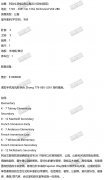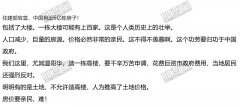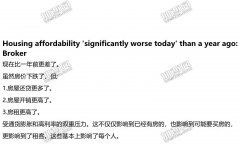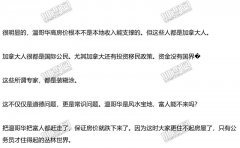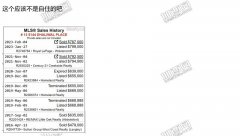在加拿大
有一些看不懂,请懂行的帮忙解释一下好吗?谢谢哈Lot size:40*130*120*120 四个数字是什么?Amount/year $*****/2014Taxes/year $*****/2013这两项对房子价格的参考价值有多大?UFFI是什么?目前就这些,谢谢啊
评论
三木 说:不是温哥华的,同看不懂呀点击展开...是Ontario的
评论
三木 说:不是温哥华的,同看不懂呀点击展开...那 generally政府估价和property tax对房价有多大参考作用?
评论
三木 说:内行,不看政府估价,外行,依赖政府估价点击展开...我属于外行中的外行了。内行不看政府估价,这个是说明政府估价并没有很大的权重去影响房价?或者可以说是根据不同眼光/标准?能否做稍微详细的解释?作为大外行,听别人说政府估价不可信,可也不敢完全不信,只是拿不好该信到哪个程度,毕竟这个股价也是根据房子本身估算出来的。请解惑。
评论
mengman 说:有一些看不懂,请懂行的帮忙解释一下好吗?谢谢哈Lot size:40*130*120*120 四个数字是什么?Amount/year $*****/2014Taxes/year $*****/2013这两项对房子价格的参考价值有多大?UFFI是什么?目前就这些,谢谢啊点击展开...lot size 4个数应该是按顺序4条边的长度,40*130*120*120 是个前窄后宽的梯形,前后相差很大,感觉很奇怪。
评论
40 x 130 x 120 x120, 单位大概是feet,可能是个等边梯型的地,也可能不太规则的形状。另外从维基翻到的UFFI.http://en.wikipedia.org/wiki/Urea-formaldehydeUrea-formaldehyde foam insulation

 Urea-formaldehyde insulationUrea-formaldehyde foam insulation (UFFI) dates back to the 1930s and made a synthetic insulation with R-values near 5.0 per inch. It is basically a foam, like shaving cream that is easily injected into walls with a hose. It is made by using a pump set and hose with a mixing gun to mix the foaming agent, resin and compressed air. The fully expanded foam is pumped into areas in need of insulation. It becomes firm within minutes but cures within a week. UFFI is generally spotted in homes built before the 1970s; one should look in basements, crawl spaces, attics, and unfinished attics. Visually it looks like oozing liquid that has been hardened. Over time, it tends to vary in shades of butterscotch but new UFFI is a light yellow color. Early forms of UFFI tended to shrink significantly. Modern UF insulation with updated catalysts and foaming technology have reduced shrinkage to minimal levels (between 2-4%). The foam dries with a dull matte color with no shine. When cured, it often has a dry and crumbly texture.Safety concernsUrea-formaldehyde foam insulation (UFFI) was used extensively in the 1970s. Homeowners used UFFI as a wall cavity filler at the time in order to conserve energy. In the 1980s, concerns began to develop about formaldehyde vapor emitted in the curing process, as well as from the breakdown of old foam. Emission rates exceeding 3.0 - 5.0 parts per million (ppm) cause a variety of adverse health effects impacting the eyes, nose, and respiratory system. Consequently, its use was discontinued. The urea-formaldehyde emissions decline over time and significant levels should no longer be present in the homes today. Modern replacement options for UFFI include melamine formaldehyde resin, low-emission UF insulation materials, and polyurethane.UFFI was usually mixed at the location of use while constructing the home’s walls. It was then injected inside the walls, the curing process occurs, and the final product acts as an insulating agent. Because less information was known about the toxic health effects of formaldehyde in the 1970s, extra formaldehyde was often added to the mixture to ensure that the curing process would occur completely. Since the UFFI was not a well-sealed product [open-celled foam], any excess formaldehyde in the insulation would off-gas into the home's living space. The early UFFI materials were also affected by moisture and heat which compounded the offgassing concerns. When temperature rises, residuals of formaldehyde contained in the insulation are released and migrate into indoor air. Remedial actions to take when formaldehyde levels exceed recommended levels include sealing off the any outlets for the vapors; sealing any cracks or openings in interior walls; removing any sources of water or moisture that come in contact with the insulation; applying one or more layers of vapor-barrier paint; increasing the air exchange rate with outside air in buildings that are tightly sealed; or covering walls with Mylar or vinyl paper. Aluminum foil is a useful alternative for barricading vapors. Generally there is not an off-gassing concern with older UFFI insulation, since those materials have already cured. Removal is a costly and tedious option for UFFI, and it requires the installation of replacement insulation.Health effectsHealth effects occur when urea-formaldehyde based materials and products release formaldehyde into the air. Generally there are no observable health effects from formaldehyde when air concentrations are below 1.0 ppm. The onset of respiratory irritation and other health effects, and even increased cancer risk begins when air concentrations exceed 3.0-5.0 ppm. This triggers watery eyes, nose irritations, wheezing and coughing, fatigue, skin rash, severe allergic reactions, burning sensations in the eyes and throat, nausea, and difficulty in breathing in some humans (usually > 1.0 ppm). Occupants of UFFI insulated homes with elevated formaldehyde levels experienced systemic symptoms such as headache, malaise, insomnia, anorexia, and loss of libido. Irritation of the mucus membrane (specifically eyes, nose, and throat) was a common upper respiratory tract symptom related to formaldehyde exposure. However when compared to control groups, the frequency of symptoms did not exceed the controls except when it came to wheezing, difficult breathing, and a burning skin sensation. Controlled studies have suggested that tolerance to formaldehyde's odor and irritating effects can occur over a prolonged exposure.http://en.wikipedia.org/wiki/Wikipedia:Citation_needed
Urea-formaldehyde insulationUrea-formaldehyde foam insulation (UFFI) dates back to the 1930s and made a synthetic insulation with R-values near 5.0 per inch. It is basically a foam, like shaving cream that is easily injected into walls with a hose. It is made by using a pump set and hose with a mixing gun to mix the foaming agent, resin and compressed air. The fully expanded foam is pumped into areas in need of insulation. It becomes firm within minutes but cures within a week. UFFI is generally spotted in homes built before the 1970s; one should look in basements, crawl spaces, attics, and unfinished attics. Visually it looks like oozing liquid that has been hardened. Over time, it tends to vary in shades of butterscotch but new UFFI is a light yellow color. Early forms of UFFI tended to shrink significantly. Modern UF insulation with updated catalysts and foaming technology have reduced shrinkage to minimal levels (between 2-4%). The foam dries with a dull matte color with no shine. When cured, it often has a dry and crumbly texture.Safety concernsUrea-formaldehyde foam insulation (UFFI) was used extensively in the 1970s. Homeowners used UFFI as a wall cavity filler at the time in order to conserve energy. In the 1980s, concerns began to develop about formaldehyde vapor emitted in the curing process, as well as from the breakdown of old foam. Emission rates exceeding 3.0 - 5.0 parts per million (ppm) cause a variety of adverse health effects impacting the eyes, nose, and respiratory system. Consequently, its use was discontinued. The urea-formaldehyde emissions decline over time and significant levels should no longer be present in the homes today. Modern replacement options for UFFI include melamine formaldehyde resin, low-emission UF insulation materials, and polyurethane.UFFI was usually mixed at the location of use while constructing the home’s walls. It was then injected inside the walls, the curing process occurs, and the final product acts as an insulating agent. Because less information was known about the toxic health effects of formaldehyde in the 1970s, extra formaldehyde was often added to the mixture to ensure that the curing process would occur completely. Since the UFFI was not a well-sealed product [open-celled foam], any excess formaldehyde in the insulation would off-gas into the home's living space. The early UFFI materials were also affected by moisture and heat which compounded the offgassing concerns. When temperature rises, residuals of formaldehyde contained in the insulation are released and migrate into indoor air. Remedial actions to take when formaldehyde levels exceed recommended levels include sealing off the any outlets for the vapors; sealing any cracks or openings in interior walls; removing any sources of water or moisture that come in contact with the insulation; applying one or more layers of vapor-barrier paint; increasing the air exchange rate with outside air in buildings that are tightly sealed; or covering walls with Mylar or vinyl paper. Aluminum foil is a useful alternative for barricading vapors. Generally there is not an off-gassing concern with older UFFI insulation, since those materials have already cured. Removal is a costly and tedious option for UFFI, and it requires the installation of replacement insulation.Health effectsHealth effects occur when urea-formaldehyde based materials and products release formaldehyde into the air. Generally there are no observable health effects from formaldehyde when air concentrations are below 1.0 ppm. The onset of respiratory irritation and other health effects, and even increased cancer risk begins when air concentrations exceed 3.0-5.0 ppm. This triggers watery eyes, nose irritations, wheezing and coughing, fatigue, skin rash, severe allergic reactions, burning sensations in the eyes and throat, nausea, and difficulty in breathing in some humans (usually > 1.0 ppm). Occupants of UFFI insulated homes with elevated formaldehyde levels experienced systemic symptoms such as headache, malaise, insomnia, anorexia, and loss of libido. Irritation of the mucus membrane (specifically eyes, nose, and throat) was a common upper respiratory tract symptom related to formaldehyde exposure. However when compared to control groups, the frequency of symptoms did not exceed the controls except when it came to wheezing, difficult breathing, and a burning skin sensation. Controlled studies have suggested that tolerance to formaldehyde's odor and irritating effects can occur over a prolonged exposure.http://en.wikipedia.org/wiki/Wikipedia:Citation_needed
·加拿大新闻 从追面子到享自我,宝马购车观转变
·加拿大新闻 看到快买加国Costco新晋爆款刷屏
·加拿大新闻 移民急刹车见效!加拿大人口首次出现历史性大幅下降
·加拿大新闻 每周连轴转80小时加拿大医生自爆行业黑幕
·加拿大新闻 万锦、Newmarket多家奶茶店/美甲店/理发店被指控+开罚单
·中文新闻 “这是掩盖”:科斯蒂·麦科尔的前夫在纽约歌手死亡童话故事
·中文新闻 米歇尔·基根 (Michelle Keegan) 和马克·赖特 (Mark Wright) 是溺爱小女



